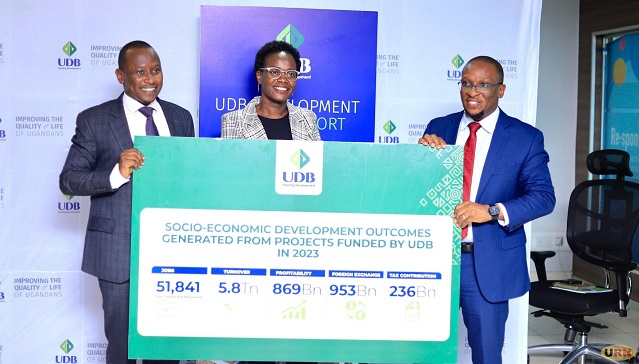
Kampala, Uganda | THE INDEPENDENT | The Uganda Development Bank last year lent out more than 600 billion shillings to different projects on top of other non-financing activities, aimed at creating positive impact on the social, economic progress of the country.
In measuring how successful their plans were, the Bank annually takes an impact assessment of the development activities, highlighted in successes in boosting highlighting job creation, output value, foreign exchange and tax generated by the enterprises the bank supported.
A major highlight of the financial performance report was creating and maintaining 51,841 jobs and a total output value of 5.8 trillion shillings. Jobs specifically created in 2023 were 3,959.
“Our financial and non-financial interventions are designed to deliver high socio-economic value, including job creation, increased production output, and foreign exchange earnings while contributing to government revenues through tax,” said Patricia Ojangole, the Managing Director UDB.
Ojangole said their objective is not only to act transparently, but also grow Uganda’s only development finance institute sustainably.
On the employment impact, UDB says while there was an increase of 404 jobs in the number of created and maintained jobs compared to the previous year, 41.21 of these were permanent and the rest temporary.
Most of the temporary jobs were (41.5 percent) were in the primary agriculture sector, mainly because of the nature of the sector where activities increase and reduce seasonally, according to UDB Francis Mwesigye, UDB Chief Economist.
Mwesigwa says the positivity in this was that most of the jobs went to the youths, a section of the population that is hardest-hit by unemployment, and that most of them were gainful, capable of lifting Ugandans out of poverty.
This was emphasized as commendable due to the fact that of the shareholders of these enterprises, 33 percent were youth, 39 women, and 0.2 percent persons with disabilities.
There has also been an increase in the number of women in senior managerial positions from 37 to 43 percent, while youths took 29 percent of senior managerial positions and 19 percent of the board memberships, factors that the Bank attributed to sustained affirmative action towards women, youth and SMEs.
On profitability, UDB says the companies or enterprises it supported posted 869 in profitability, with health and agriculture projects returning higher margins than tourism and hospitality.
Mwesigwa says quality in the jobs is also measured by the social benefits that go with them, and these include social protection and others.
On the contribution to the national economy, the supported enterprises generated about 236 billion shillings in 2023, with the manufacturing sector contributing 47 percent of this, followed by agro-processing with 27.8 percent and primary agriculture 15 percent.
The other contributors were tourism and education, among other minor ones.
In contribution to GDP, the Bank estimates that the projects added about 5.8 trillion shillings or 3.2 percent of GDP, but that these figures do not tell the real picture because of the limitations in data availability, according to Dr Mwesigye.
The 2023 Report under the theme, “Transforming Lives: The Role of UDB in Driving Socio-economic Transformation in Uganda,’ shows that the earnings from locally produced products meant for exports registered a 47 percent increase from 649 billion to 953 billion shillings.
This was mainly due to the increased production in the manufacturing and agro-processing sectors, and shows the strength of the local industries. Importantly, two thirds of all raw materials utilized in the UDB-funded enterprises were locally sourced, a clear sign of the growing strength and potential of our local industries, according to Mwesigye.
The assessment also reveals where the money invested goes, showing water for irrigation, better breeds, key raw materials and post-harvest handling.
Specifically, in post-harvest handling losses in the grain subsector, they amount to between 35 and 40 percent, but UDB reports that they supported enterprises registered 25 percent losses, which was better than the national average.
On the environment and climate mitigation contribution, the Bank has focused on supporting enterprises that do not increase carbon emission or those that have mitigation functions included in their plans.
According to the report, 72 percent of assessed enterprises were certified by NEMA in 2023, up from 56.5 percent in 2022.
On emissions, enterprises that have embraced renewable emit about 32.8 metric tons of carbon, significantly lower than those using non-renewable energy, which account for about 69.18 Carbon Footprint per project.
“It’s not just important, but crucial to emphasize the need for a transition to cleaner energy sources, especially in the infrastructure sector, where reliance on fossil fuels persists,” the report says, adding, “this transition is not just a choice but a necessity for the preservation of our environment. We must act with urgency and determination to make this shift.”
The Bank also plans to continue pushing for sustainable waste management with enterprises prioritizing waste reduction, recovery, reuse, and recycling as critical strategies to promote environmental sustainability.
On human capital development, the Bank has focused on skilling, featuring construction of infrastructure for learners like classroom blocks, libraries and dormitories, as well as scholastic materials. Focus is mainly on far-to-reach areas which are usually underserved.
The report shows that in 2023, the Bank’s interventions led to an increase in enrollment in the supported institutions to 480,062 learners, 60 percent being female and 1 percent persons with disabilities.
On health, the supported projects led to installation of 61 intensive care units, driven by the experience of the Covid 19 pandemic which revealed that the country heavily lacked such facilities, while the number of beds grew three times over the period to 388.
The interventions also drove the number of medical workers from 263 to 593 in the supported health centres, while the cumulative number of patients more than doubled to 248,000.
******
URN
 The Independent Uganda: You get the Truth we Pay the Price
The Independent Uganda: You get the Truth we Pay the Price



